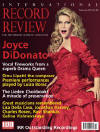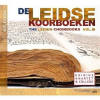Texte paru dans: / Appeared in:
*

International Record Review - (02/2013)
Pour
s'abonner / Subscription information
Etcetera
KTC1412

8711801014128 (ID279)
Consultez toutes les évaluations recensées pour ce cd
~~~~ Reach all the evaluations located for this CD

Here in Australia, some of our post-war immigrants from Europe retain practices and attitudes their home countries abandoned long ago. A former colleague of mine of Dutch parentage came to love and collect recordings of sacred music by Monteverdi, Palestrina and Victoria (under my gentle guidance). Her mother, who had not set foot in her Dutch Reformed church for decades, was nevertheless greatly disturbed by hearing ‘Roman music’ in her daughter’s house and could not bear it to be played in her presence. In contrast, in Holland itself the appetite for sacred music is very great among its sophisticated music-loving population. The once largely Calvinist Netherlands now thoroughly embraces its pre-Reformation artistic and musical heritage. There is even some embarrassment today over the cultural iconoclasm of the sixteenth and early seventeenth centuries. Last August, a guide in Utrecht Cathedral tried to tell me that the smashed faces on the Medieval reliefs were the result not of Reformation zeal but merely a careless bricklayer.
While an unimaginable amount of destruction was caused in northern Europe by Protestant iconoclasts (or clumsy tradesmen) to paintings, sculptures, sacred vessels, tabernacles, reliquaries, liturgical books and the like, Catholic music being portable and widely disseminated tended to survive better. In the case of sacred polyphony, no European people has as rich a patrimony as those from the Low Countries. Composers from these lands were employed throughout Europe from the late fourteenth to the mid-seventeenth centuries, so that a great deal of their music survives from countries where the Reformers were unable to destroy it. Unlike the German Lutherans, whose founder’s love of music (Josquin Desprez’s in particular) tempered their hostility to polyphony, the Dutch Calvinists hunted down and destroyed Catholic scores wherever they could find them — even organs incurred their wrath. (A Presbyterian friend tells me she can remember organs being called ‘the Devil’s Whistle’ by the stricter members of her congregation.)
This brings us, at last, to the story of the Leiden Choirbooks, to which the Dutch label Et’Cetera has so far devoted three lavish double CD volumes and a planned three more to go. The survival of these immensely valuable books is a minor miracle considering what the lengthy booklet essay (by the Utrecht-based Josquin scholar Eric Jas) calls a ‘storm like none other [that] raged through the Netherlands in the autumn of 1566 during which the contents of hundreds of Catholic churches, chapels and cloisters were either destroyed or stolen’. The iconoclastic storm hit the Pieterskerk in Leiden on August 25th and 26th that year; but the choirbooks of the College of the Seven Liturgical Hours had been hidden away and locked well enough to escape the fury. The six Leiden Choirbooks were assembled for the College by the musical copyist Anthonius de Blauwe, who apparently performed the same service for religious guilds in various other Dutch cities all long destroyed, of course. So they provide an almost unique insight into the everyday musical repertory of devout societies in pre-Reformation Netherlands.
Even more importantly, alongside the big-name Netherlandish composers with international careers such as Josquin and Gombert, whose scores can be found across Europe, these choirbooks preserve the music of many high-quality local composers who would otherwise be completely unknown. One such composer represented in this volume is the Fleming Jheronimus (sic) Vinders, whose Magnificat (with an unusual textual variation) is one of his few surviving works. It is a very appealing and luminous work, which I have listened to more often than any other piece in this set. Another Flemish composer is Cornelius Canis from Ghent, who was a pupil of Gombert. Despite his present-day obscurity, Canis had a more glittering career than Vinders, having worked for Charles V and briefly for Ferdinand. Canis’s substantial Missa ‘Pastores Loquebantur’ is a really first-rate work and makes me keen to hear more of his music. (The Egidius Kwartet has recorded a motet and ten chansons of Canis for Et’Cetera, reviewed in August 2000, which I must track down.) The other composers selected for this volume are much better known, at least to collectors of Renaissance polyphony. They represent the flower of the post-Josquin generation and there are too many masterpieces recorded here to single out any piece.
For all his diligence and good taste, the copyist de
Blauwe left some puzzles for modern performers. As carefully explained by Dr
Jas, de Blauwe had his own rather eccentric system of indicating mensuration
in the scores that does not seem to reflect the composers’ own intentions
and produces in practice some very odd results. The modern singers here have
experimented slightly with tempo differences to capture what may have been
the practices of their Leiden forebears, without adhering slavishly to de
Blauwe’s markings . The Leiden Choirbooks series is being produced under the
auspices of the leading Dutch Early Music vocal ensemble, the Egidius
Kwartet. However, for this series it is joined by a ‘college’, which is in
effect a full chamber choir of mixed voices. Presumably the original forces
in Leiden a small group of men and boys; nevertheless the choir here is pure
voiced, lithe and shapes the music most beautifully. There appears to be no
director, which make its perfect ensemble and subtlety of phrasing all the
more impressive. As with the previous volumes (Volume 1 was reviewed in
March 2011), this is truly a luxurious production in terms of presentation,
documentation and profusion of lovely and apposite illustrations. All in
all, another triumph for Et’Cetera and the Egidius Kwartet, which certainly
merits an IRR Outstanding award.
Fermer la fenêtre/Close window
Cliquez l'un ou l'autre
bouton pour découvrir bien d'autres critiques de CD
Click either button for many other reviews


